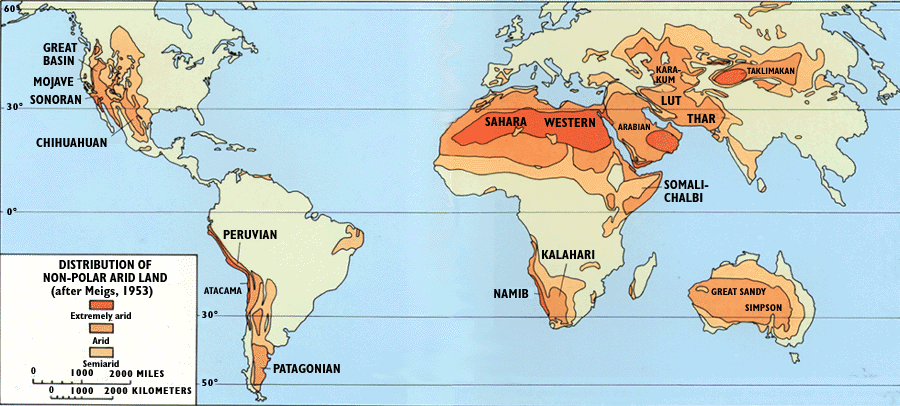The “Distribution of Non-Polar Arid Land” by Meigs (1953) is a study that maps and categorizes arid regions around the world. The work focuses on non-polar arid areas, excluding the polar regions. Meigs used various criteria to classify arid land, including rainfall, temperature, and vegetation. The study provides detailed maps and descriptions of arid regions, highlighting their location, extent, and characteristics. It also discusses the impact of arid conditions on human activities, such as agriculture, settlement, and resource management. The work is considered a significant contribution to the field of climatology and geography, providing valuable insights into the distribution and nature of arid regions globally.

The major findings of Meigs’ study on the “Distribution of Non-Polar Arid Land” include:
- Identification and Mapping: Meigs identified and mapped arid regions around the world, excluding the polar regions. He used various criteria, such as rainfall, temperature, and vegetation, to classify arid land.
- Classification of Arid Regions: Meigs categorized arid regions based on their characteristics, including extremely arid, arid, and semi-arid zones. He provided detailed descriptions of each category, highlighting their unique features and conditions.
- Location and Extent: The study provides information on the location and extent of arid regions. It identifies major arid areas, such as the Sahara, Arabian Peninsula, and Australian deserts, and outlines their geographical boundaries.
- Impact on Human Activities: Meigs discussed the impact of arid conditions on human activities, including agriculture, settlement, and resource management. He highlighted the challenges and adaptations required in arid regions.
- Vegetation and Climate: The study examines the vegetation and climate of arid regions. It describes the types of plants that can survive in arid conditions and discusses the climate patterns, including temperature fluctuations and rainfall patterns.
- Comparative Analysis: Meigs compared arid regions across different continents, highlighting similarities and differences in their characteristics and impacts on human societies.
Why do western margins of continents are more likely to have tropical deserts?

The western margins of continents are more likely to have tropical deserts due to several factors:
- Rain Shadow Effect: The presence of mountain ranges on the western side of continents leads to a rain shadow effect. As moist air from the ocean moves inland, it encounters these mountains and is forced to rise. As the air ascends, it cools and loses its moisture, leading to rainfall on the windward side of the mountains. The air then descends on the leeward side, becoming drier and leading to arid conditions.
- Subsidence and High Pressure: The descending air on the leeward side of the mountains creates a high-pressure zone. High-pressure areas are associated with sinking air, which inhibits cloud formation and precipitation, resulting in arid conditions.
- Ocean Currents: The ocean currents along the western margins of continents can also play a role in the formation of tropical deserts. Cold ocean currents along these coasts can lead to cooler air temperatures and reduced evaporation, which in turn reduces the amount of moisture available for precipitation.
- Prevailing Winds: The direction of prevailing winds can also influence the distribution of tropical deserts. In many cases, the prevailing winds blow from the east towards the west, carrying moisture from the ocean. As these winds encounter the mountain ranges on the western margins of continents, they are forced to rise and release their moisture, leading to arid conditions on the leeward side.
- Subtropical Highs: The subtropical high-pressure systems, also known as the subtropical ridges, are located roughly between 20° and 30° latitude. These high-pressure systems are characterized by sinking air, which inhibits cloud formation and precipitation. As a result, the regions under these high-pressure systems tend to be arid. The western margins of continents, particularly in the subtropical latitudes, are more likely to be under the influence of these high-pressure systems, leading to the formation of tropical deserts.
These factors combined contribute to the formation of tropical deserts on the western margins of continents, such as the Sahara in North Africa, the Atacama in South America, and the Namib in Southern Africa.